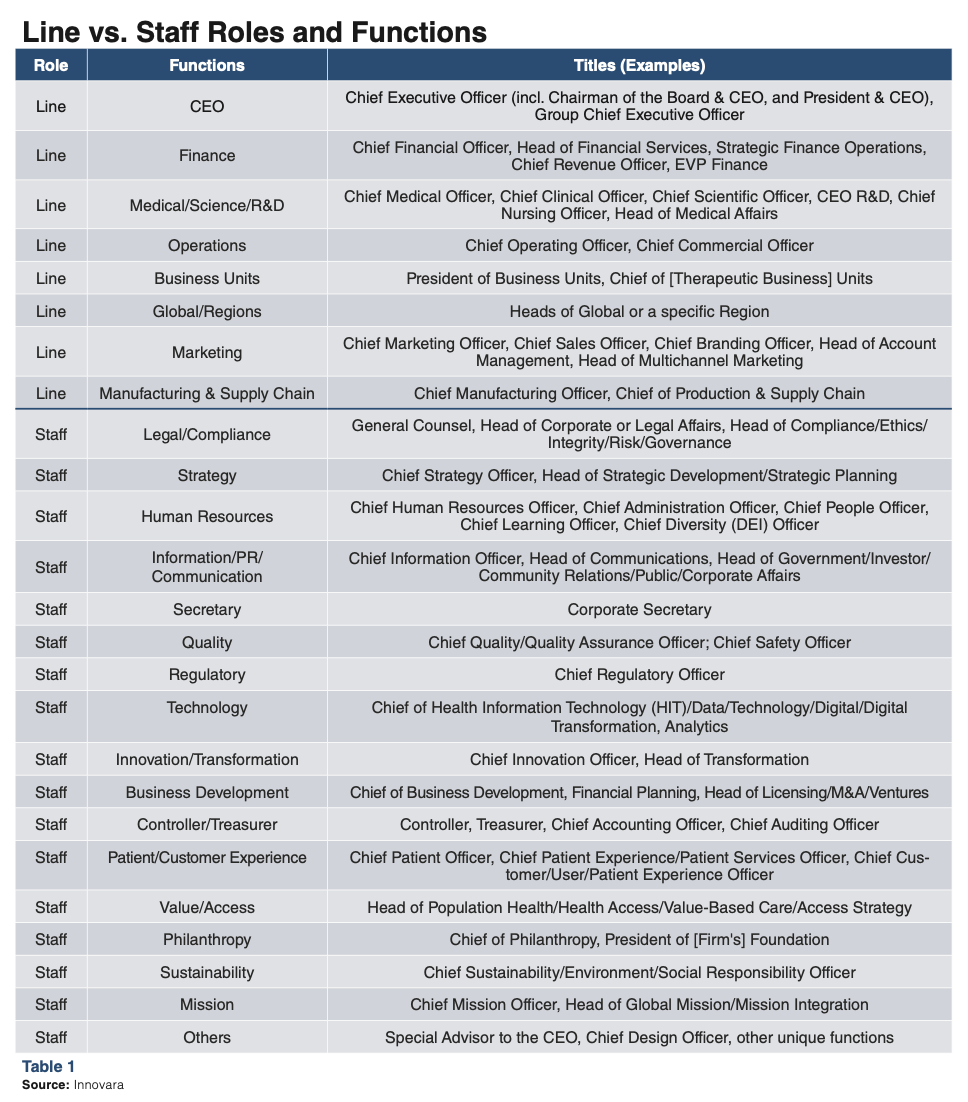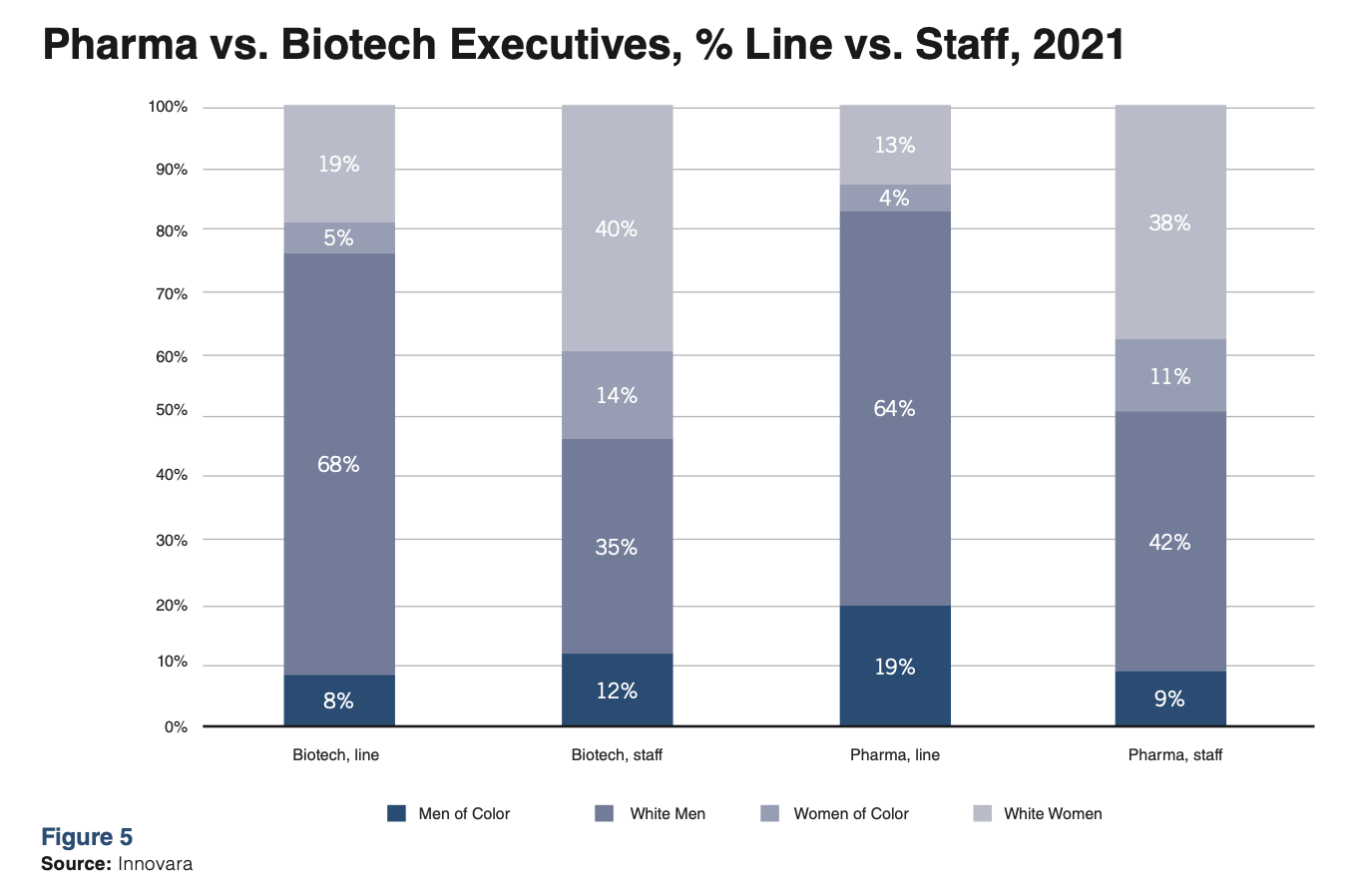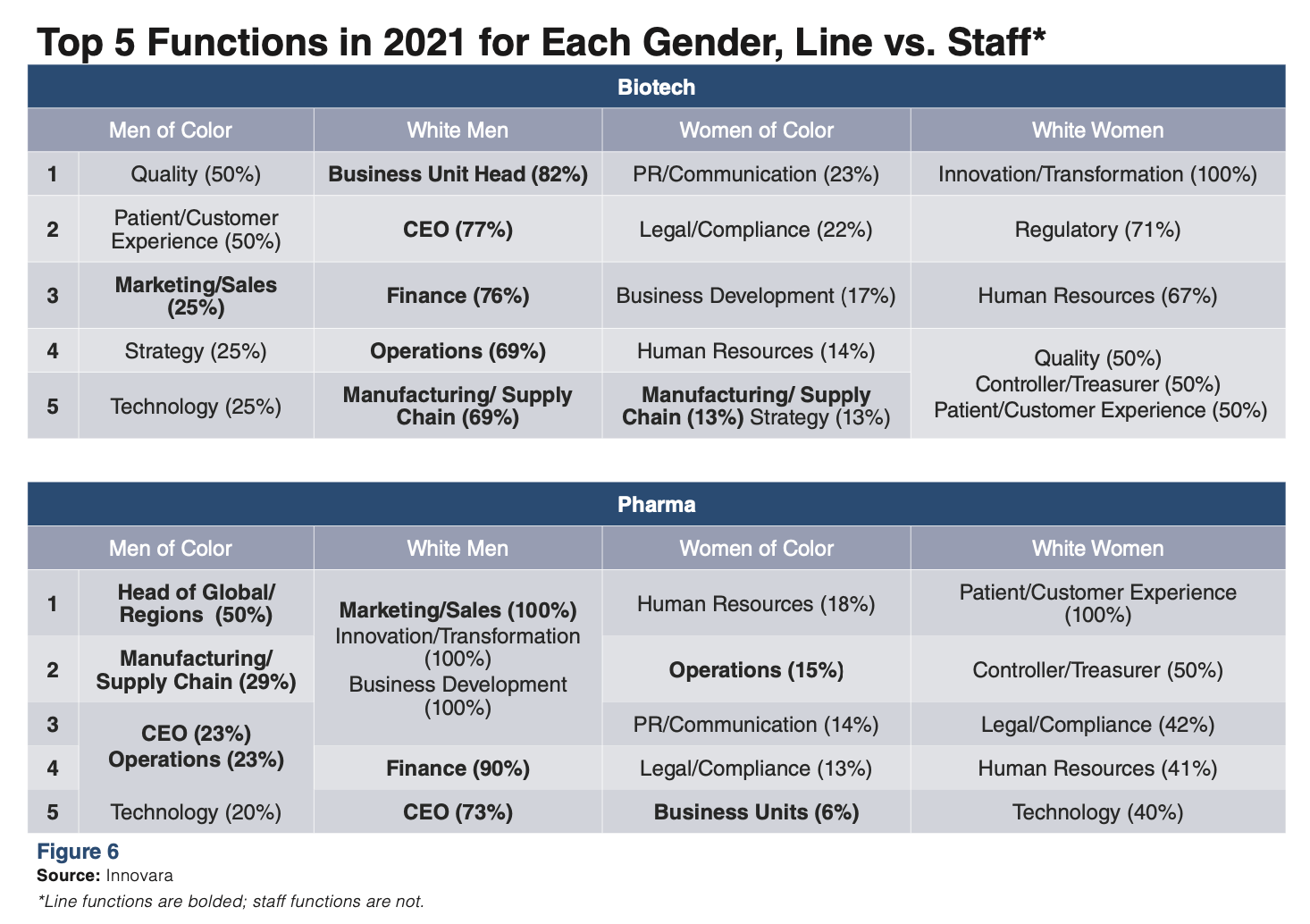Women and Diversity in Industry C-Suites: New Scorecards Tell the Story
Benchmark study across healthcare sectors measures progress in advancing women and people of color into top leadership roles.

Management expert Peter Drucker is best known for his quote, “You can’t manage what you can’t measure.” This is especially true when it comes to diversity, equity, and inclusion (DE&I) in the c-suite. Without DE&I data, there can be no accountability. And there has never been a DE&I scorecard for pharma and biotech executive leadership until now.
This is the first public release of data from an annual national landmark study, Health Alert 2022: Women, Diversity and Leadership in the Businesses of Healthcare, conducted jointly by the Center for Women in Politics and Public Policy; the University of Massachusetts, Boston, and Innovara, Inc. Since 2018, we have been tracking executive leadership teams of top pharma and biotech companies. In 2018, there was a combined total of 374 executives, growing to 497 in 2021. We studied them by gender and ethnicity, line vs. staff roles and specific functions, and who gets promoted from within and outside the firm, as well as from where they came.
The aim of the study is simple: to annually benchmark companies across all healthcare sectors—including those in manufacturing such as pharma and biotech, and in services such as health systems and insurance—to keep the industry accountable for its progress advancing women and people of color into top leadership roles. The following scorecards will help us all to do this.
Top pharma and biotech firms benchmarked from 2018–2021
We selected 41 pharma and biotech market leaders based on US market revenues (see Figure 1 below). Together, these firms accounted for over $730 billion in worldwide pharmaceutical revenues in 2020, of which $370 billion were from the US market (51% of their global revenues).1 These firms accounted for two-thirds of global pharmaceutical revenues and over 72% of US market revenues in 2020. They also represented over 9% of 2020 national healthcare spending.2 We set a minimum threshold based on US market revenues: $3 billion for pharma and $1 billion (rounded) for biotech.

We wanted to include some of the smaller but significant, innovative biotech/specialty firms in therapeutic niches such as rare diseases, women’s health, dermatology, mental health, ophthalmology, and certain cancers. As we analyzed the data, we realized it was beneficial to separate the pharma and biotech sectors, as there were significant differences between the two in virtually all diversity criteria.
Progress made by women in the C-Suite
In 2018, women leaders represented 21% of pharma executive teams. By 2021, they were up by 35%, to 28%. Optimistically, by 2027, pharma’s average will be 40% or higher (see Figure 2 below).

In 2018, women biotech executives were already pulling ahead of pharma’s, comprising an average of 25% of the top leadership team. This rose almost 40% to an average of 35% in 2021. At this rate, biotech’s average will be at parity by 2024 (see Figure 3 below).

The increase in biotech gender diversity was realized mainly by significantly increasing the number of women leaders. In 2018, both sectors averaged 11 leaders per executive team. By 2021, this had not changed for pharma; however; biotech executive teams had grown to 15.
So which companies fared best in terms of achieving parity? In 2018, only one biotech (Alexion) had reached parity and two pharmas had at least 40% women leaders. By 2021, nine companies had at least 40% gender parity, and four reached parity: Biogen, Organon, UCB (biotechs), and Eli Lilly (pharma) (see Figure 4 below).

Not all executives have equal power
The next challenge was to determine any differences between genders in terms of line vs. staff roles. This was unexpectedly challenging. We had to first define line and staff, and then assign specific functions to each. Most executives know the differences: Line roles are in control of the money, people, production, and commercialization of product; staff are in supporting and service roles. But our industry is slightly unique. When we queried executives in the c-suite, most believed that research and development (R&D) and medical/scientific affairs organizations should also be considered line, so we delineated these and other c-suite roles as line vs. staff (see Table 1 below).

From there, we looked at how many executives were in staff vs. line roles. As you can see from Figure 5 (see below), in 2021, white men held the majority of line roles in pharma and biotech—64% and 68%, respectively. White women in biotech and men of color in pharma each reached 19% of line positions, but women of color represented only 5% of biotech and 4% of pharma line roles. The balance of white women, people of color, and white men all held staff roles.

Not surprisingly, men dominated all the major line functions. Women dominated legal and human resources (HR) functions (the two top staff functions), the latter by a landslide in biotech (81%). Interestingly, men of color dominated global/regional top jobs in pharma, not biotech, even though there was a comparable number of global/regional jobs in each sector.
In the biotech sector, men of color were found mostly in medical/science/R&D leadership roles. In addition, among the top five functions in 2021 by gender, men of color were most represented in the areas of quality and patient/customer experience (See Figure 6 below).

When we dug further into CEOs/presidents, we saw the stark confirmation: Yes, most are white men. It is a particularly harsh reality that across all four years, we saw no men of color as CEOs in biotech and no women of color as CEOs in pharma.
We also found it interesting that as of 2021 there were only four companies (10%) that had c-suite roles explicitly covering DE&I. These were Biogen and Regeneron (biotechs) and Lilly and AbbVie (pharmas). It is noteworthy that in 2018, there were no companies with these titles (or variations) in the c-suite.

But it is important for diversity to be represented on an executive level. “For DE&I to have a true business impact, it must be leader-led,” says Smita Pillai, chief diversity, equity, and inclusion officer at Regeneron. “By ensuring that the CDO has a seat at the top table with the CEO and other senior-most leaders of the organization, you are signaling that it is a key human and business imperative for the company.”
In short, not all roles in the c-suite are equal. White men still dominate decision-making, the money, and the power of both sectors of the industry by a large margin. This is likely to be the case for many years to come unless the pipeline of women, and especially people of color, is transformed. Moreover, we observed that firms are pulling in employees from other parts of the world. That may be a good and logical solution to encourage international leadership diversity, but the optics mask the fundamental need to develop a pipeline of Black non-Hispanic and Hispanic Americans who can rise to the c-suite—not just in staff roles but in line roles.
Are we looking at a zero-sum game?
In the last two years of his tenure as US President for Merck & Co. (2017–2018), Robert McMahon, a current board member of Inheris Pharmaceuticals and an investment advisor at Venture Investors, led the transformation to more women in leadership. “This [transformation] didn’t come without some angst,” says McMahon. “As the organization moved forward, there was obvious concern among the senior men whom I had charged with making the change. I heard, ‘Am I in the process of displacing myself? You know, this is a zero-sum equation, right? How do I think about this in terms of my future?’”
Health Alert 2022 shows that it has been at least a zero-sum game for white men in both line and staff roles during the past four years, with declines of 17% and 33%, respectively, in biotech, and 7% and 17%, respecitively, in pharma. We also see a decline in men of color in staff roles in pharma, down 23%, while we see both white women and women of color make gains (24% and 58%, respectively).
We further found that while the number of new bloods in the c-suite was fairly constant in biotech between 2019 and 2021, there was a sharp decline in pharma in 2020 and 2021.
So where are the new hires coming from? Figure 7 below shows while biotech pulls more from pharma, pharma promotes significantly more from within or reaches outside the industry altogether. Employees joining pharma from non-healthcare- related industries included companies such as LEGO and Nissan, and from highly transferrable functions such as HR and finance.

It is important to mention that in 2019 and 2020, when Bristol Myers Squibb acquired Celgene, executive leaders leaving either company accounted for 20% of new external hires.
Profound lack of diversity at the top
Our final step was to determine how ethnically diverse executive teams are. As of 2021, among the non-white executives, the dominant ethnicities in pharma were a diverse mix of Asians, whereas the dominant ethnicities in biotech were those from the Indian subcontinent (and more specifically, of Indian ethnicities). Of the remaining ethnicities—Black non-Hispanic, Arab, and Hispanic—there were very few of each in either sector and the Hispanics were decidedly white.
What’s the industry to do?
While it seems at first glance that women are well on their way to achieving parity, and that biotech is friendlier to women and people of color than pharma, Health Alert 2022 highlights the stark disparities in executive leadership positions held by people of color, and particularly women of color.
Despite some improvements in the past few years, we clearly still have a long way to go.

It may be hard to prove the business case, but once an organization has experienced gender and ethnic diversity, there’s no going back. Adriana Guana, MD, vice president of medical strategy and scientific affairs at LEO Pharma—one of the few firms in the study with more than 40% women leaders—understands this.
“One of LEO Pharma’s differentiators is our culture of diversity, equity, and inclusion,” she says. “This commitment translates into open, trustworthy dialogue and direct communication, promoting teamwork and breaking down silos. For those who have been in a very diverse company, we cannot see ourselves working in a non-inclusive environment. In making the business case, you constantly need to look for ways to keep diversity and engagement at work.”
Reshma Kewalramani, MD, FASN, chief executive officer and president at Vertex Pharmaceuticals, has instilled a culture across the company that is passionate about diversity. Among a number of exemplary initiatives, she describes how Vertex is particularly focused on identifying and developing talents whose backgrounds and identities are traditionally underrepresented in the biotech sector. “An example of career development focused specifically for Black and Latinx leaders is our Executive Mentoring Circles program,” she says. “Black and Latinx leaders receive direct mentorship and support from members of our executive committee to foster their career growth.”

Laurie Nsiah-Jefferson, PhD, director of the Center for Women in Politics and Public Policy at the University of Massachusetts, Boston, and co-principal investigator, describes achieving diverse and inclusive leadership as a destination, not a journey.
“To do this work, organizations must be committed to learning about the factors which lead to underrepresentation, including bias, racism, and discrimination, which can get in the way of the advancement for people of color and women in hiring, promotion, and other opportunities,” she says. “They must also have the courage to institute transformative organizational change in the service of equity.”
Nsiah-Jefferson also stresses that to grow the talent pipeline in the healthcare industry, it is critical to fund and support STEAM and other relevant initiatives at all levels of education. Moreover, the firms’ leaders need to actively engage with mid- to higher-level employees through sponsorship, mentorship, and leadership development programs. “It is critical that we not only focus on diversity, but also on inclusion and equity to ensure that the views and perspectives of diverse individuals are valued and engaged, and that there is equity in opportunity,” she says. “This can’t happen unless it is proactively led from the top.”
Acknowledgement: We would like to acknowledge the joint Health Alert team: Laurie Nsiah-Jefferson, PhD; René Meade; Samir Podder, PhD; Emma Tynan; Alessia Casale; Arushi Mittal; and Ethan Thayumanavan. We also would like to thank Deepak Mittal, CEO of NexGen Invent, for providing IT strategy, technology, and related data science services.
Barri Blauvelt, CEO of Innovara, Inc., a global healthcare learning and development firm, and co-principal investigator of the Health Alert 2022 study
References
- Milovic M. Global pharmaceutical sales from 2017 to 2021, by region. Statista. February 2022. https://www.statista.com/statistics/272181/world-pharmaceutical-sales-by-region/
- Hartman M et al. National Health Care Spending In 2020: Growth Driven By Federal Spending In Response To The COVID-19 Pandemic. Health Affairs. Dec. 15, 2021. https://doi.org/10.1377/hlthaff.2021.01763
Other sources
- MiloNomenclature: Laws, M. Why we capitalize ‘Black’ (and not white). Columbia Journalism Review. June 16, 2020. https://www.cjr.org/analysis/capital-b-black-styleguide.php/
- The Diversity Style Guide. 2022. https://www.diversitystyleguide.com/


.png&w=3840&q=75)

.png&w=3840&q=75)



.png&w=3840&q=75)



.png&w=3840&q=75)















